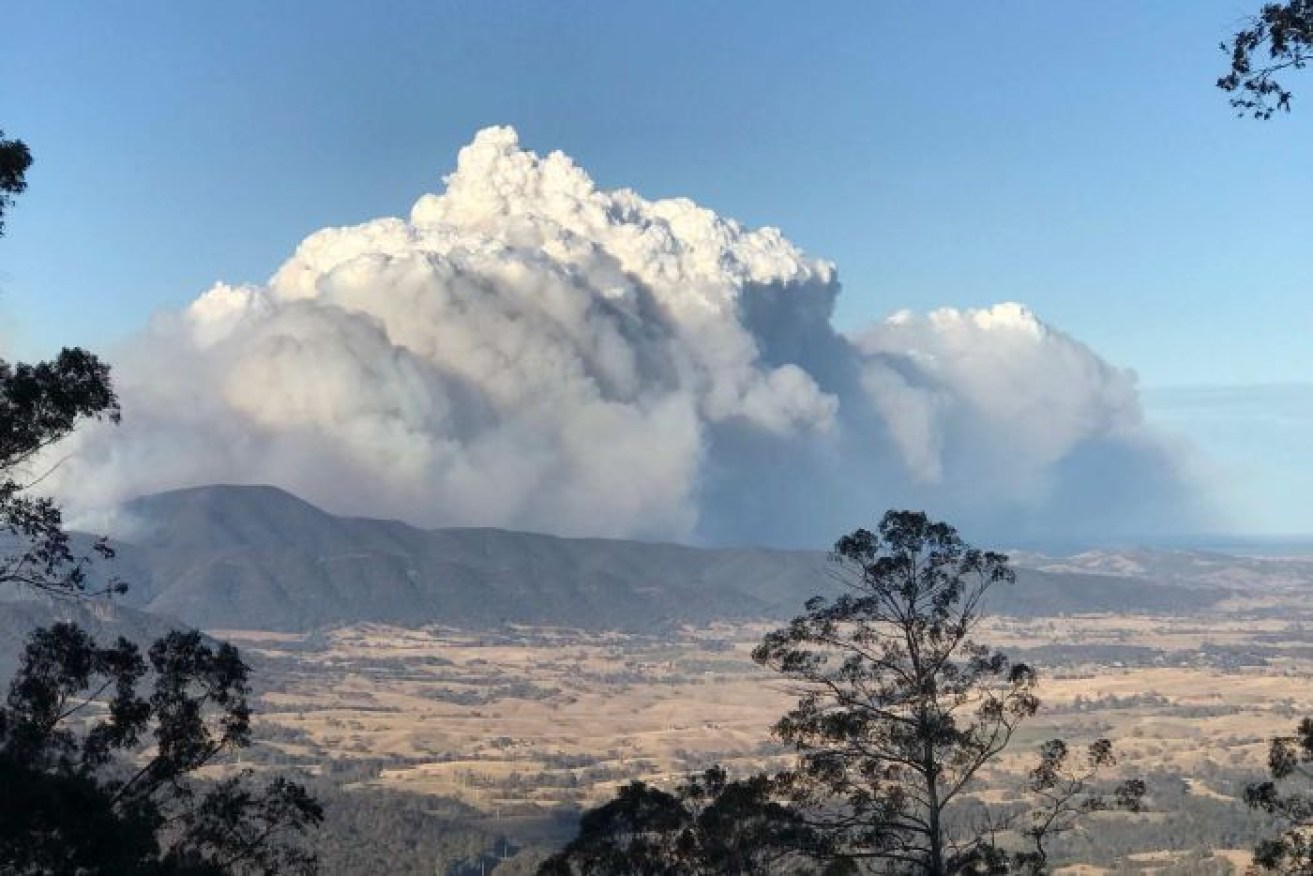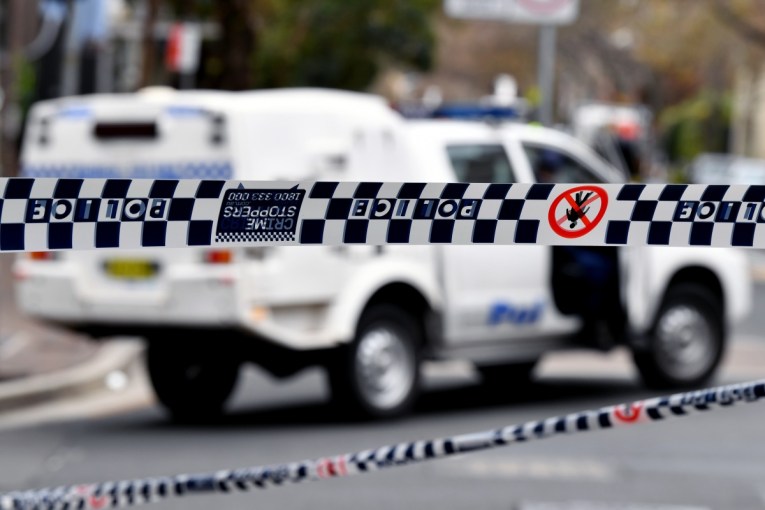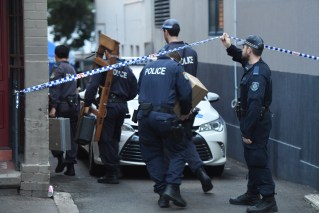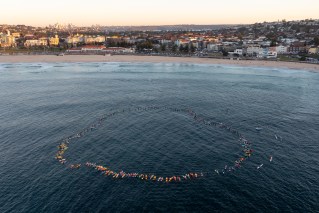Emergency bushfire warnings issued in NSW after strong winds stoke Newcastle inferno

The fire at Bemboka over Bega Valley in southern NSW. Photo: Twitter/Daniel Strictland
Firefighters across NSW have scrambled to suppress several major blazes as strong winds fanned flames and prompted emergency declarations.
Emergency alert telephone messages were sent to residents near the Newcastle blaze after another of the wind changes that have plagued firefighters’ efforts transformed the fire’s flank into a wide advancing front.
The blaze in the Salt Ash area — currently at emergency warning level — had consumed more than 1,000 hectares by late on Saturday night.
The Rural Fire Service (RFS) said a late south-westerly wind change impacted the fire ground and activity increased in the evening.
“People in the areas of Tanilba Bay, Mallabumla and Lemon Tree Passage areas should shelter as the fire front approaches,” the Rural Fire Service (RFS) advised.
“Take shelter in a solid structure to protect yourself from the heat of the fire.”
Rural Fire Service Deputy Commissioner Rob Rogers said the flames may be pushed towards Tanilba Bay.
“We’ve warned those communities of that and we’ve got a lot of fire trucks in there to protect homes, but until such time as the winds calm down or that fire impacts and we’re able to extinguish it as it arrives, we will remain concerned about that community,” he said.
Smoke filled blanketed the district on what was a regional soccer grand final day, with hundreds of people stuck at a local sports ground as roads were locked down.
EMERGENCY WARNING- Plains Station Rd, Tabulam (Tenterfield LGA)- The fire is burning around the town of Tabulum & has crossed the Clarence River. Residents should take shelter in a solid structure. It is too late to leave https://t.co/K2c3UF6SX0 #nswrfs #nswfires pic.twitter.com/FVV3FYiJWf
— NSW RFS (@NSWRFS) August 18, 2018
Video footage of the Salt Ash Fire which is currently burning close to Oyster Bay, N of Lemon Tree Passage Rd. If your plan is to leave early, leave now towards Nelson Bay Rd. Stay up to date: https://t.co/t02gbrb7Wh #nswrfs #nswfires pic.twitter.com/RiG05Z04ol
— NSW RFS (@NSWRFS) August 18, 2018
Two major fires have continued to burn on the state’s south coast, including west of Ulladulla, where flames broke containment lines and triggered another emergency declaration.
About an hour later, crews had rectified the situation and the incident was downgraded.
But that blaze has torn through about 2200 hectares and remains out of control.
Further south, the RFS is also battling to control a fire near Bega that has destroyed three homes.
“The firefighters did some good work supported by aircraft but it has been quite difficult firefighting at all those fires today, because of the winds we’ve been experienced,” Mr Rogers said.
In the rural town of Tabulam, in the state’s north-east, residents were warned of the danger posed by live wires after reports power poles were downed by a fire that jumped the Clarence River.
“Take shelter in a solid structure and protect yourself from the heat of the fire. It is too late to leave,” the RFS said of the Tabulam fire.
Emergency telephone messages have been sent to residents in the area.
It also triggered an emergency declaration, with warnings embers could create spot fires that may threaten homes well before the actual fire front arrived.
‘Fire season is here’
Mr Rogers said while it was not unheard of to have bushfires in August, the severe nature of the current blazes was concerning.
He blamed the drought.
“It just makes these fires burn so much hotter, so it is concerning and the thing that really worries us if if we don’t get the spring rain which traditionally we would get … you add heat into this,” he said.
“At the moment, the days are still quite cool, but if we start getting 35 or 40 degrees and these winds and low humidity in these very dry landscapes, we simply won’t be able to stop some of these fires.”
Mr Rogers urged residents to use the current spate of fires – some 70 burning across NSW – as a warning to prepare their homes for an emergency and think about a bushfire survival plan.
“People should be using this as a reminder that the fire season is basically here,” he said.
He said while Sunday’s forecast for shows strong winds continuing, there should be lower temperatures.
Overnight, crews will use the opportunity to contain as many fires as possible before the winds take off again.
Tributes for pilot killed in crash
Yesterday, a waterbombing helicopter crashed while working on a fire ground near Ulladulla on the south coast, killing experienced pilot Allan Tull instantly.

Pilot Allan Tull was killed in the helicopter crash on the NSW south coast, where firefighters have been battling a large bushfire. Photo: Facebook
Transport safety officials today continued investigating why it crashed. It is believed that the helicopter’s water bucket became tangled in trees.
Mr Tull has been remembered as “a great friend to everyone in the industry”.
His colleague Mark Harrold, chief pilot at Sydney Helicopters, fought back tears as he remembered Mr Tull’s sense of humour and wit.
He died doing something he loved, Mr Harrold added.
“He was a character,” he said.
“He was a wonderful man – a man of integrity – and one that’s going to be very, very greatly missed in our industry.”
Mr Tull started working in Australia in 2000 and was involved in firefighting missions over the past 18 years.
He had also flown overseas and was an experienced pilot.
Mr Tull leaves behind a son, Joseph, and partner, Sheila.
RFS commissioner Rob Rogers said his volunteers were hit hard by the tragedy, but had to keep going.








